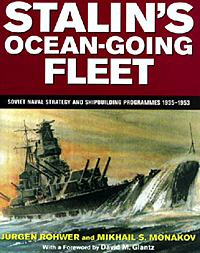 Stalin’s Ocean-Going Fleet, by Jürgen Rohwer and Mikhail S. Monatov, Frank Cass Publishers, 2001, 34 pp, $57.50
Stalin’s Ocean-Going Fleet, by Jürgen Rohwer and Mikhail S. Monatov, Frank Cass Publishers, 2001, 34 pp, $57.50
Although billed as a discussion of Stalin’s desire for a big-ship navy, this book gives the reader much more. Using records released since the collapse of the Soviet Union, and written by two eminent naval historians, it first describes the state of the Navy in post-Revolutionary Russia, with detailed listings of ships in service, ships planned, and the political and military deliberations that went into Soviet naval policy. Grouped by five-year plans, it covers the shipbuilding programs of the Soviet Navy from 1935 through 1953 and the death of Stalin.
Second, through those deliberations, it shows dozens of might-have-been ship designs. A few were laid down, but most never left the drawing board. While the statistics are not complete, they do include drawings and information on variants of many of the designs.
Third, it covers the debate in the Soviet Navy between advocates of “blue water” sea power (i.e., battleships and aircraft carriers) and the “small navy” school. The disciples of a large conventional navy fought a continuous uphill battle: Against Russia’s limited industrial capacity, her continental geography, the “imperialist Mahanian” stain of a conventional navy, and a defense hierarchy dominated by the Army. The “small navy” school made more sense for Russia. With few ports, limited resources for the armed forces, and continental rivals, a coastal navy of light vessels, aircraft, and submarines could be built quickly and cheaply. A coastal navy gives a nation fewer options than a blue-water fleet, but Russia would not be able to use the options offered by a big fleet, even if they could build it.
This debate continued through the 1920s and early 1930s, until Stalin made a decision. The Soviet Union needed a big navy - not only large in numbers, but based around capital ships – battleships and battle cruisers. His decision seemed ratified by events when the Russians were unable to protect their merchant shipping during the Spanish Civil War.
Although the big navy admirals were at first pleased with his choice, they were frustrated when they found his plans did not include aircraft carriers. They were also aware that it would be a decade before the Soviet Fleet would be anywhere near parity with the other great powers. Like Germany’s Z plan, the Soviet Navy didn’t expect to complete Stalin’s buildup until the late 1940s.
The book provides only a basic overview of Soviet naval operations in WW II, but does list the many changes to the shipbuilding programs, as well as war losses. Stalin’s plans were disrupted by the WW II, but only delayed. Even while the conflict raged, Stalin was thinking about his postwar fleet. In the war, light craft and submarines proved to have the greatest utility, while their few heavy units were liabilities.
In spite of this, after the war Stalin repeated his orders for the construction of a big navy, and the scale of his obsession became clear. While the admirals wanted to adjust the designs and numbers of ships to incorporate the lessons of WW II, Stalin still wanted big ships with big guns, and would agree to only a few light carriers, even after they had proved themselves the dominant naval weapon of the war. Stalin wanted big all-gun ships in 1935, and he still wanted them in 1950, even while guided missiles and high-performance aircraft were revolutionizing naval warfare.
Before WW II, the capital ship was the symbol of a great power, and Stalin wanted those symbols flying the hammer and sickle around the world. The military utility of the ships had nothing to do with his decision. His battleships were nothing more than hood ornaments for Soviet foreign power. After Stalin’s death, his big ships were all canceled, and the numbers of the smaller vessels scaled back dramatically. His successor, Nikita Khruschev, embraced the idea of a smaller, more modern navy with guided missiles and nuclear weapons, but ironically, Russia’s lack of a big navy caused its humiliation in the Cuban Missile Crisis of 1962, and started another long climb toward big navy status.
Stalin’s Ocean-Going Fleet shines a bright light into a poorly known period of Soviet naval history. This isn’t a cheap book, but when you see the mountains of data painstakingly compiled by the authors, you’ll agree that it’s worth the price.
BT
Back to The Naval Sitrep #23 Table of Contents
Back to Naval Sitrep List of Issues
Back to MagWeb Master Magazine List
© Copyright 2002 by Larry Bond and Clash of Arms.
This article appears in MagWeb (Magazine Web) on the Internet World Wide Web.
Other military history and related articles are available at http://www.magweb.com